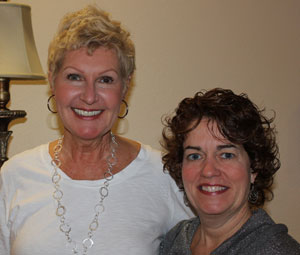By John Sailer

|
|
Nanette Michaels (l), vice president of Henry Ford Optimeyes, and marketing director, Katie Darr, attended Transitions Academy 2013, where they were among the nominees for regional Retailer of the Year. |
Partnering with a major hospital system brought success to a chain of franchised optometrists formerly known as First Optometry Eye Care Center and currently known as
Henry Ford Optimeyes. Now, the group is poised for further growth as it works toward partnering with another prominent Michigan health system.
The 17-location group's current growth phase started in 1997 when it decided to reposition itself in a changing industry and began investigating opportunities for expansion.
"One of the companies we looked at was the
Henry Ford Health System, a major hospital system in Detroit," Nanette Michaels, Henry Ford Optimeyes vice president, told dba. "They also had a managed care division called Health Alliance Plan (HAP), and we thought if we were able to partner with this system, in particular their department of ophthalmology, that might make sense to us."
The result was a 50/50 merger with the Henry Ford Health System and a name change to Henry Ford Optimeyes. With the partnership and the name change, "Our goal was to be able to promote to the consumer that we provide the full continuum of eyecare, from cradle to grave," said Michaels. "At any stage of your life, we would be able to take care of you."
The benefits of joining forces with the health system began immediately and have been building ever since. The Henry Ford Health System has 30,000 employees, and there are a half million members of HAP. "We worked hard building that relationship," Katie Darr, marketing director, told dba. "When we walked in we saw less than 10 percent of the employees. Now, we see close to 90 percent."
Being a part of the health system also provides a great referral source for Henry Ford Optimeyes. "If your doctor, nurse or pediatrician, for example, is wearing our glasses, and their patient asks, 'Where do you go for eyewear?' they'll say, 'I go to my partner at Henry Ford Optimeyes. That's where I go and where I take my family.'"
In turn, Henry Ford Optimeyes is a great referral source for the many other divisions of the health system as well. If a patient needs a primary care physician, has trouble getting out of the examination chair, or if the optometrist detects the early signs of diabetes or hypertension, for example, they can refer them to another practitioner within the system.
Henry Ford Optimeyes also uses its 300,000-circulation quarterly newsletter, InFocus, to further enhance its relationship with the rest of the health system. "In every issue, Katie works with some business division within the health system to give them some exposure," said Michaels. "For example, in a spring issue we covered the allergy team, which also provided a connection to our division, because there are allergies affecting the eye and contact lens issues as well."
Being a part of the health system expands the optical group's reach into the community as well. For example, its staff and patients participate in a blood drive and a heart walk every year, and they help raise funds for the Josephine Ford Cancer Institute and the SandCastles Grief Support Program for children who have lost a loved one, both a part of the overall health system. This connects Henry Ford Optimeyes, its staff and its patients to their local community and helps build its success.
To further motivate its staff, Henry Ford Optimeyes has enlisted the help of The Gallup Organization to develop more "engaged" employees. Michaels explained: "Gallup believes that there are three levels of individual within an organization. There's a disengaged employee where everything's wrong, and they actually try to pull people into their camp. Then you have an unengaged employee, who is not unhappy, but it's just okay, it's work, they have a job. Then you have the highly engaged employee. They're the ones who really make things happen. Statistically, Gallup has said that most organizations focus on the disengaged employee, because they are the problem. The organizations that grow a highly engaged workforce really don't focus on that group. We have found if we focus on the middle group, the unengaged, we're able to move many more of those people to the highly engaged group, and the disengaged people actually leave on their own."
By using Gallup's motivational techniques, such as recognizing employees with Employee of the Month and Employee of the Year awards, and by training staff members to "learn and grow," Henry Ford Optimeyes has created a staff of primarily "highly engaged" employees. According to Gallup, most organizations have a ratio of eight highly engaged employees to every one disengaged employee. Starting in the program in 2007 with a ratio of six to one, the optical group ballooned to a ratio of eight to one in 2010, and most recently to an astounding ratio of 40 to one last April.
Fully acquired by the health system in Jan. 2004, Henry Ford Optimeyes remains its only for profit division. "We work really hard to maintain our independence," said Michaels.
Among the various divisions of the overall health system, Henry Ford Optimeyes was the first to institute electronic health records with the installation of
ExamWRITER from eyefinity/OfficeMate. While implementing the software initially proved time consuming, eventually the group's practitioners became more proficient at typing their notes into the EHR system rather than writing them out as they had in the past. Soon the entire health system will be using electronic health records as well, which will be shared electronically among all the divisions.
Today, Henry Ford Optimeyes operates 17 locations, 10 of which are traditional satellite offices of approximately 2,500 square feet, with about 750 frames, and a doctor on duty two evenings a week until 8 p.m. The other seven locations are Super Vision Centers ranging in size from 10,000 to 20,000 square feet, with Henry Ford Ophthalmology onsite in addition to optometry, over 2,500 frames on the selling floor, full service labs and open seven days a week.
With two of its Super Vision Centers having outgrown their locations, plans are underway to move them to larger facilities. "We need more examination rooms, and ophthalmology has looked to add some specialty services," said Michaels. "They are already two successful facilities, but I think we'll see dramatic growth out of the two of them with the change in locations next year."
With only 17 stores, Henry Ford Optimeyes currently ranks at number 15 in Vision Monday's Top 50 U.S. Optical Retailers, as reported in the May 2012 issue. Now, as the Henry Ford Health System works toward merging with another prominent Michigan health provider,
Beaumont Health System, and its 18,000 employees, this successful optical group is destined for even more growth in the future.
 |
 |
|
The Dearborn, Mich., location is one of seven Super Vision Centers featuring optometry, ophthalmology, a full service lab and open seven days a week. |
Henry Ford Optimeyes' Super Vision Centers feature more than 2,500 frames on the selling floor. |
Back to Newsletter